-

新人教版高中英语选修2Unit 2 Reading for writing教学设计
The theme of this section is to express people's views on studying abroad. With the continuous development of Chinese economic construction, especially the general improvement of people's living standards, the number of Chinese students studying abroad at their own expense is on the rise. Many students and parents turn their attention to the world and regard studying abroad as an effective way to improve their quality, broaden their horizons and master the world's advanced scientific knowledge, which is very important for the fever of going abroad. Studying abroad is also an important decision made by a family for their children. Therefore, it is of great social significance to discuss this issue. The theme of this section is the column discussion in the newspaper: the advantages and disadvantages of studying abroad. The discourse is about two parents' contribution letters on this issue. They respectively express their own positions. One thinks that the disadvantages outweigh the advantages, and the other thinks that the advantages outweigh the disadvantages. The two parents' arguments are well founded and logical. It is worth noting that the two authors do not express their views on studying abroad from an individual point of view, but from a national or even global point of view. These two articles have the characteristics of both letters and argumentative essays1.Guide the students to read these two articles, and understand the author's point of view and argument ideas2.Help the students to summarize the structure and writing methods of argumentative writing, and guides students to correctly understand the advantages and disadvantages of studying abroad3.Cultivate students' ability to analyze problems objectively, comprehensively and deeply

新人教版高中英语选修2Unit 2 Using langauge-Listening教学设计
? B: Absolutely! Getting involved with Chinese cultural activities there definitely helped a lot. I got to practice my Chinese on a daily basis, and I could learn how native Chinese speakers spoke.? A: What do you feel is your biggest achievement?? B: Learning Chinese characters! I have learnt about 1,500 so far. When I first started, I didn't think it was even going to be possible to learn so many, but now I find that I can read signs, menus, and even some easy newspaper articles.? A: What are you most keen on?? B: I've really become keen on learning more about the Chinese culture, in particular Chinese calligraphy. As I have learnt Chinese characters, I have developed a great appreciation for their meaning. I want to explore Chinese characters by learning how to write them in a more beautiful way. ? A: Finally, what do you want to say to anyone interested in learning Chinese?? I have really become keen on learning more about the Chinese culture, in particular Chinese Calligraphy. As I have learnt Chinese character, I have developed a great appreciation for their meaning. I want to explore Chinese characters by learning how to write them in a more beautiful way.? A: Finally, what do you want to say to anyone interested in learning Chinese?? B: I'd say, give it a shot! While some aspects may be difficult, it is quite rewarding and you will be happy that you tried.? A: Thanks for your time. ? B:You're welcome.

新人教版高中英语选修2Unit 4 Using langauge-Listening教学设计
The theme of the listening section is " talking about scenery and culture along a journey."The part is designed to further lead the students to understand Canadian natural geography and social environment, and integrated into the cultural contrast by mentioning the long train journey from Beijing to Moscow routes. On this basis, the part activates students related travel experience, lets the student serial dialogue, guides the student to explore further the pleasure and meaning of the long journey, and Chinese and foreign cultural comparison.The part also provides a framework for the continuation of the dialogue, which is designed to provide a framework for students to successfully complete their oral expressions, and to incorporate an important trading strategy to end the dialogue naturally.1. Help students to understand and master some common English idioms in the context, and experience the expression effect of English idioms.2. Guide the students to understand the identity of different people in the listening context, and finish the dialogue according to their own experience.3. Instruct the students to use appropriate language to express surprise and curiosity about space and place in the dialogue, and master the oral strategy of ending the dialogue naturally.1. Instruct students to grasp the key information and important details of the dialogue.2. Instruct students to conduct a similar talk on the relevant topic.

新人教版高中英语选修2Unit 5 Reading and thinking教学设计
The theme of this activity is to learn the first aid knowledge of burns. Burns is common in life, but there are some misunderstandings in manual treatment. This activity provides students with correct first aid methods, so as not to take them for granted in an emergency. This section guides students to analyze the causes of scald and help students avoid such things. From the perspective of text structure and collaborative features, the text is expository. Expository, with explanation as the main way of expression, transmits knowledge and information to readers by analyzing concepts and elaborating examples. This text arranges the information in logical order, clearly presents three parts of the content through the subtitle, accurately describes the causes, types, characteristics and first aid measures of burns, and some paragraphs use topic sentences to summarize the main idea, and the level is very clear.1. Guide students to understand the causes, types, characteristics and first aid methods of burns, through reading2. Enhance students’ ability to deal withburnss and their awareness of burns prevention3. Enable students to improve the ability to judge the types of texts accurately and to master the characteristics and writing techniques of expository texts.Guide students to understand the causes, types, characteristics and first aid methods of burns, through readingStep1: Lead in by discussing the related topic:1. What first-aid techniques do you know of ?CPR; mouth to mouth artificial respiration; the Heimlich Manoeuvre
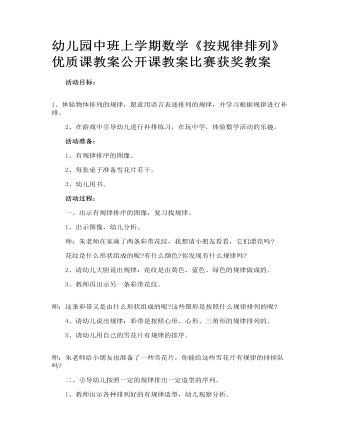
幼儿园中班上学期数学《按规律排列》优质课教案公开课教案比赛获奖教案
一、出示有规律排序的图像,复习找规律。 1、出示图像,幼儿分析。 师:朱老师在家画了两条彩带花纹,我想请小朋友看看,它们漂亮吗? 花纹是什么形状组成的呢?有什么颜色?你发现有什么规律吗? 2、请幼儿大胆说出规律:花纹是由黄色、蓝色、绿色的规律做成的。 3、教师再出示另一条彩带花纹。
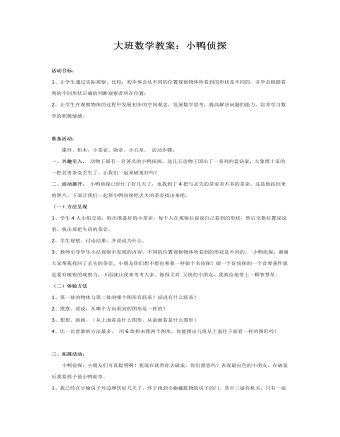
大班数学教案:小鸭侦探
准备活动: 课件、积木、小茶壶、勋章、小五星。活动步骤:一、兴趣引入。动物王国有一名著名的小鸭侦探,这几天动物王国出了一系列的盗窃案,大象博士家的一把名贵茶壶丢失了。让我们一起来破案好吗?二、活动展开。小鸭侦探已经忙了好几天了,也找到了4把与丢失的茶壶差不多的茶壶,这是他拍回来的照片,下面让我们一起帮小鸭侦探把丢失的茶壶找出来吧。(一)方法呈现1、学生4人小组交流,取出准备好的小茶壶,每个人在观察后说说自己看到的形状,然后交换位置说说看。找出那把失窃的茶壶。 2、学生观察、讨论结果,并说说为什么。 3、教师引导学生小结观察中发现的内容,不同的位置观察物体所看到的形状是不同的。小鸭侦探:谢谢大家帮我找回了丢失的茶壶。小朋友你们想不想也和我一样做个名侦探?做一个好侦探的一个首要条件就是要有敏锐的观察力,下面就让我来考考大家。做得又对又快的小朋友,我就给他带上一颗智慧星。
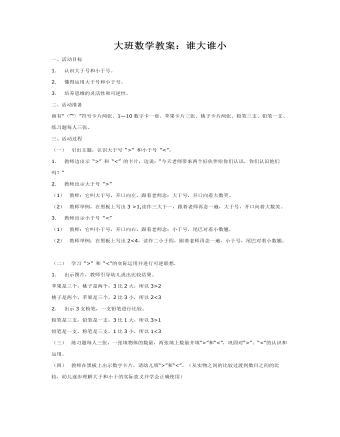
大班数学教案:谁大谁小
二、活动准备 画有“〈”“〉”符号卡片两张、1—10数字卡一套、苹果卡片三张、桃子卡片两张、粉笔三支、铅笔一支、练习题每人三张。 三、活动过程 (一) 引出主题,认识大于号 “>” 和小于号 “<”。 1. 教师边出示 “>” 和 “<” 的卡片,边说:“今天老师带来两个好伙伴给你们认识,你们认识他们吗?” 2. 教师出示大于号 “>” (1) 教师:它叫大于号,开口向左,跟着老师念:大于号,开口向着大数笑。 (2) 教师举例,在黑板上写出3 >1,读作三大于一,跟着老师再念一遍,大于号,开口向着大数笑。 3. 教师出示小于号 “<” (1) 教师:它叫小于号,开口向右,跟着老师念:小于号,尾巴对着小数翘。 (2) 教师举例:在黑板上写出2<4,读作二小于四,跟着老师再念一遍,小于号,尾巴对着小数翘。
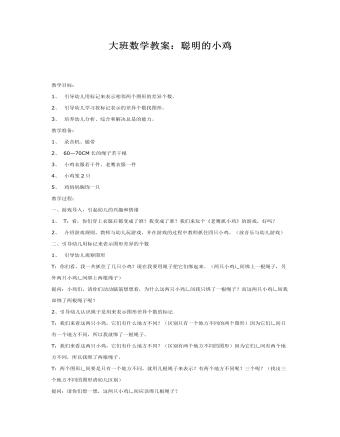
大班数学教案:聪明的小鸡
2、 引导幼儿学习按标记表示的差异个数找图形。 3、 培养幼儿分析、综合和解决总是的能力。 教学准备: 1、 录音机、磁带 2、 60—70CM长的绳子若干根 3、 小鸡衣服若干件、老鹰衣服一件 4、 小鸡笼2只 5、 鸡妈妈胸饰一只 教学过程: 一、游戏导入,引起幼儿的兴趣和情绪 1、 T:看,你们穿上衣服后都变成了谁?我变成了谁?我们来玩个《老鹰抓小鸡》的游戏,好吗? 2、 介绍游戏规则,教师与幼儿玩游戏,并在游戏的过程中教师抓住四只小鸡。(放音乐与幼儿游戏)
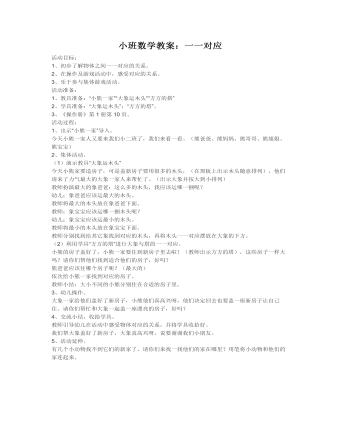
小班数学教案:一一对应
2、在操作及游戏活动中,感受对应的关系。 3、乐于参与集体游戏活动。 活动准备: 1、教具准备:“小熊一家”“大象运木头”“方方的搭” 2、学具准备:“大象运木头”;“方方的塔”。 3、《操作册》第1册第10页。 活动过程: 1、出示“小熊一家”导入。 今天小熊一家人又要来我们小二班了,我们来看一看。(熊爸爸、熊妈妈、熊哥哥、熊姐姐、熊宝宝)
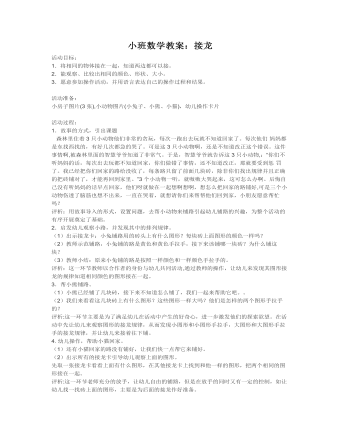
小班数学教案:接龙
2.能观察、比较出相同的颜色、形状、大小。 3.愿意参加操作活动,并用语言表达自己的操作过程和结果。 活动准备: 小房子图片(3张),小动物图片(小兔子、小熊、小猫),幼儿操作卡片 活动过程: 1.故事的方式,引出课题 森林里住着3只小动物他们非常的贪玩,每次一跑出去玩就不知道回家了。每次他们 妈妈都是东找西找的,有好几次都急的哭了。可是这3只小动物啊,还是不知道改正这个错误。这件事情啊,被森林里面的智慧爷爷知道了非常气。于是,智慧爷爷就告诉这3只小动物,:“你们不听妈妈的话,每次出去玩都不知道回家,你们做错了事情,还不知道改正,那就要受到惩 罚了。我已经把你们回家的路给没收了,每条路只留了前面几块砖,除非你们找出规律并且正确的把砖铺对了,才能再回到家里。”3个小动物一听,就嗷嗷大哭起来,这可怎么办啊。后悔自己没有听妈妈的话早点回家,他们呀就做在一起想啊想啊,想怎么把回家的路铺好,可是三个小动物伤透了脑筋也想不出来,一直在哭着,就想请你们来帮帮他们回到家,小朋友愿意帮忙吗? 评析:用故事导入的形式,设置问题,去帮小动物来铺路引起幼儿铺路的兴趣,为整个活动的有序开展奠定了基础。 2.启发幼儿观察小路,并发现其中的排列规律。 (1)出示接龙卡:小兔铺路用的砖头上有什么图形?每块砖上面图形的颜色一样吗? (2)教师示范铺路,小兔铺的路是黄色和黄色手拉手,接下来该铺哪一块砖?为什么铺这块? (3)教师小结:原来小兔铺的路是按照一样颜色和一样颜色手拉手的。 评析:这一环节教师以合作者的身份与幼儿共同活动,通过教师的操作,让幼儿来发现其图形接龙的规律知道相同颜色的图形接在一起。
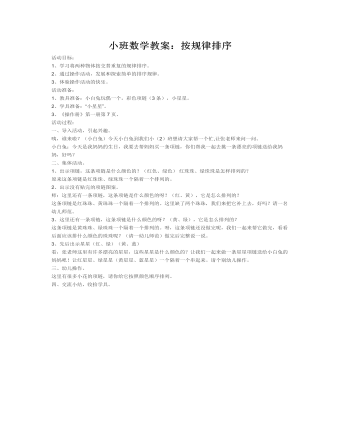
小班数学教案:按规律排序
2、通过操作活动,发展和探索简单的排序规律。 3、体验操作活动的快乐。 活动准备: 1、教具准备:小白兔玩偶一个,彩色项链(3条),小星星。 2、学具准备:“小星星”。 3、《操作册》第一册第7页。 活动过程: 一、导入活动,引起兴趣。 咦,谁来啦?(小白兔)今天小白兔到我们小(2)班想请大家帮一个忙,让张老师来问一问。 小白兔:今天是我妈妈的生日,我要去帮妈妈买一条项链,你们帮我一起去挑一条漂亮的项链送给我妈妈,好吗? 二、集体活动。
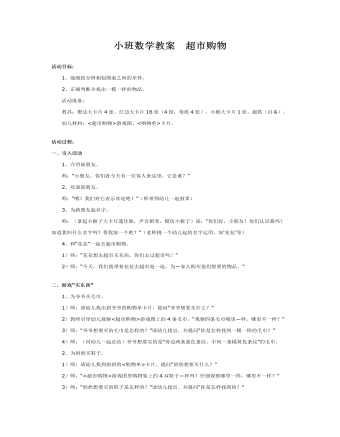
小班数学教案 超市购物
2、正确判断并找出一模一样的物品。 活动准备: 教具:橙边大卡片4张、红边大卡片16张(4组,每组4张)、小猴大卡片1张、磁铁(自备)。 幼儿材料:<超市购物>游戏图、<购物单>卡片。活动过程:一、引入活动 1、介绍新朋友。 师:“小朋友,你们看今天有一位客人来这里,它是谁?” 2、欢迎新朋友。 师:“哦!我们对它表示欢迎吧!”(师带领幼儿一起鼓掌) 3、为新朋友起名字。 师:(拿起小猴子大卡片遮住脸,声音稍变,模仿小猴子)说:“你们好,小朋友!你们认识我吗?知道我叫什么名字吗?帮我取一个吧?”(老师挑一个幼儿起的名字运用,如‘花花’等)
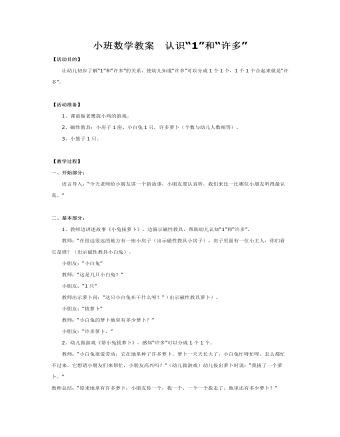
小班数学教案 认识
【活动准备】1、课前做老鹰捉小鸡的游戏。2、磁性教具:小房子1座,小白兔1只,许多萝卜(个数与幼儿人数相等)。3、小篮子1只。 【教学过程】一、开始部分: 语言导入:“今天老师给小朋友讲一个新故事,小朋友要认真听,我们来比一比哪位小朋友听得最认真。” 二、基本部分:1、教师边讲述故事《小兔拔萝卜》,边演示磁性教具,帮助幼儿认知“1”和“许多”。 教师:“在很远很远的地方有一座小房子(出示磁性教具小房子),房子里面有一位小主人,你们看它是谁?(出示磁性教具小白兔)。 小朋友:“小白兔” 教师:“这是几只小白兔?” 小朋友:“1只” 教师出示萝卜问:“这只小白兔在干什么呀?”(出示磁性教具萝卜)。 小朋友:“拔萝卜” 教师:“小白兔的萝卜地里有多少萝卜?” 小朋友:“许多萝卜。”
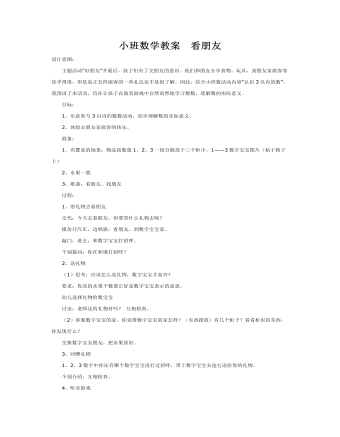
小班数学教案 看朋友
目标: 1、乐意参与3以内的数数活动,初步理解数的实际意义。 2、体验去朋友家做客的快乐。 准备: 1、布置家的场景:物品按数量1、2、3一组分散放于三个柜中。1——3数字宝宝图片(粘于椅子上) 2、水果一篮 3、歌曲:看朋友、找朋友 过程: 1、带礼物去看朋友 交代:今天去看朋友,但要带什么礼物去呢? 模仿开汽车,边唱歌:看朋友,到数字宝宝家。 敲门,进去,和数字宝宝打招呼。 个别提问:你在和谁打招呼?
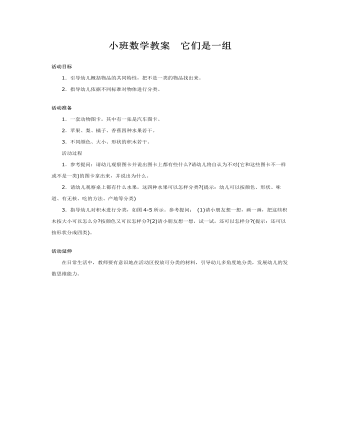
小班数学教案 它们是一组
2.指导幼儿依据不同标准对物体进行分类。活动准备1.一套动物图卡,其中有一张是汽车图卡。2.苹果、梨、橘子、香蕉四种水果若干。3.不同颜色、大小、形状的积木若干。 活动过程1.参考提问:请幼儿观察图卡并说出图卡上都有些什么?请幼儿将自认为不对(它和这些图卡不一样或不是一类)的图卡拿出来,并说出为什么。
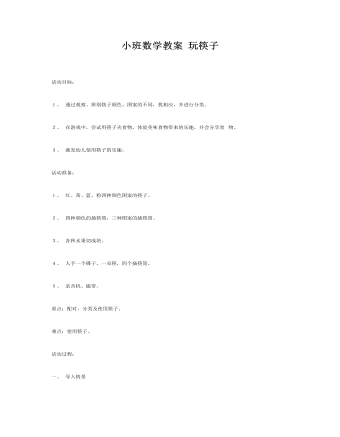
小班数学教案 玩筷子
2、 在游戏中,尝试用筷子夹食物,体验美味食物带来的乐趣,并会分享食 物。3、 激发幼儿使用筷子的乐趣。活动准备:1、 红、黄、蓝、粉四种颜色图案的筷子。2、 四种颜色的插筷筒,三种图案的插筷筒。3、 各种水果切成块。4、 人手一个碟子,一双筷,四个插筷筒。5、 录音机、磁带。重点:配对、分类及使用筷子。难点:使用筷子。活动过程:一、 导入情景1、(出示小熊)小朋友,你们好!今天我想邀请你们去我家做客,你们愿意吗? 2、但是我遇到困难了,你们帮帮我,好吗?二、学习配对1、(出示筷子)你们看,这是什么啊?2、小熊想请我们小朋友给筷子找好朋友,请你们帮他找找好朋友,好吗? 3、请你从后面的桌子上找到一支一模一样的筷子做他的好朋友,好吗? 4、现在请你们从小椅子下面找到筷子,然后去后面找到他的好朋友! 5、幼儿活动――配对。6、 “xxx,请你说说,你为什么找他做好朋友?”(请2-3名幼儿)7、 原来你们是因为他们的颜色和图案一样,才找他们做好朋友的,你们的小眼睛可真亮啊!三、学习分类1、 那你找到筷子的家在哪里吗?2、 <BR><P></P>(出示插筷筒)你们看,这就是筷子的家,它叫插筷筒。它们有什么不同啊?(颜色)这个是什么颜色啊?那这个呢?那就请你把你的筷子送回家,好吗?待会请你们轻轻地把筷子送回家,要有秩序,一个一个放,千万不要把他们送错家了。3、 幼儿活动――分类。4、 请你们看看筷子的家找对了吗?(如找错了,请一名幼儿再找,并说说为什么?)5、 哇,我们小朋友可真棒啊!把红筷子送到了红色的插筷筒里,把黄筷子送到了黄色的插筷筒里,把蓝筷子送到了蓝色的插筷筒里,把粉色的筷子送到了粉色的插筷筒里,真厉害!6、 但是,筷子想找新家了。瞧!这就是他们的新家,他们有什么不同啊?(图案)这个是什么图案?这个呢?对了,一个上面是花花的,一个有蝴蝶,还有一个上面有绿色的图案。7、 现在请你给这些筷子找新家。你喜欢什么样的筷子,你就轻轻地把他从老家拿出来,然后再把他送到新家,好吗?要一个一个有秩序,不然你把筷子弄疼了,他就不理你了。8、 幼儿活动――再次分类。9、 请你们看看筷子的家找对了吗?(如找错了,请一名幼儿再找,并说说为什么?) 10、哇!你们的小眼睛可真亮啊!比孙悟空还厉害啊!
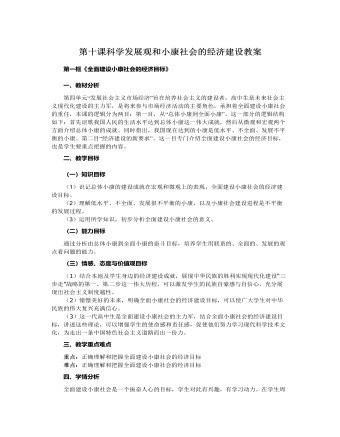
人教版高中政治必修1第十课科学发展观和小康社会的经济建设教案
一、教材分析第四单元“发展社会主义市场经济”旨在培养社会主义的建设者,高中生是未来社会主义现代化建设的主力军,是将来参与市场经济活动的主要角色,承担着全面建设小康社会的重任,本课的逻辑分为两目:第一目,从“总体小康到全面小康”。这一部分的逻辑结构如下:首先讴歌我国人民的生活水平达到总体小康这一伟大成就,然后从微观和宏观两个方面介绍总体小康的成就。同时指出,我国现在达到的小康是低水平、不全面、发展不平衡的小康。第二目“经济建设的新要求”。这一目专门介绍全面建设小康社会的经济目标,也是学生要重点把握的内容。二、教学目标(一)知识目标(1)识记总体小康的建设成就在宏观和微观上的表现,全面建设小康社会的经济建设目标。(2)理解低水平、不全面、发展很不平衡的小康,以及小康社会建设进程是不平衡的发展过程。(3)运用所学知识,初步分析全面建设小康社会的意义。
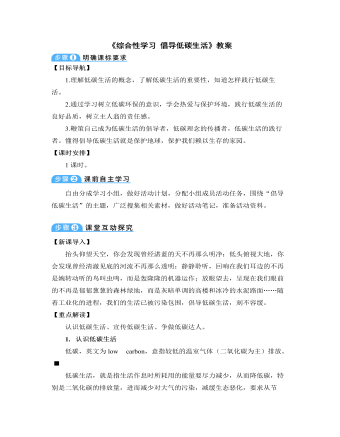
部编版语文八年级下册《综合性学习:倡导低碳生活》教案
【新课导入】抬头仰望天空,你会发现曾经湛蓝的天不再那么明净;低头俯视大地,你会发现曾经清澈见底的河流不再那么透明;静静聆听,回响在我们耳边的不再是婉转动听的鸟叫虫鸣,而是轰隆隆的机器运作;放眼望去,呈现在我们眼前的不再是郁郁葱葱的森林绿地,而是灰暗单调的高楼和冰冷的水泥路面……随着工业化的进程,我们的生活已被污染包围,倡导低碳生活,刻不容缓。【重点解读】认识低碳生活、宣传低碳生活、争做低碳达人。1. 认识低碳生活低碳,英文为low carbon,意指较低的温室气体(二氧化碳为主)排放。低碳生活,就是指生活作息时所耗用的能量要尽力减少,从而降低碳,特别是二氧化碳的排放量,进而减少对大气的污染,减缓生态恶化,要求从节水、节电、节气和回收四个环节来改变生活细节。
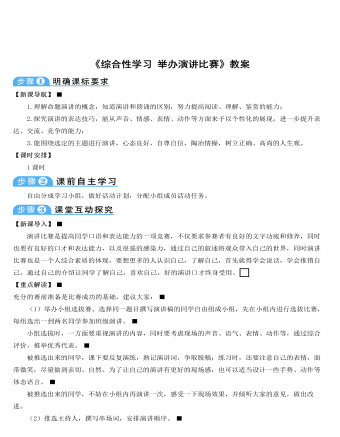
部编版语文八年级下册《综合性学习:举办演讲比赛》教案
【新课导入】演讲比赛是提高同学口语和表达能力的一项竞赛,不仅要求参赛者有良好的文字功底和修养,同时也要有良好的口才和表达能力,以及很强的感染力,通过自己的叙述将观众带入自己的世界,同时演讲比赛也是一个人综合素质的体现,要想更多的人认识自己,了解自己,首先就得学会说话,学会推销自己,通过自己的介绍让同学了解自己,喜欢自己,好的演讲口才终身受用。【重点解读】充分的赛前准备是比赛成功的基础。建议大家:(1)举办小组选拔赛。选择同一题目撰写演讲稿的同学自由组成小组,先在小组内进行选拔比赛,每组选出一到两名同学参加班级演讲。小组选拔时,一方面要重视演讲的内容,同时要考虑现场的声音、语气、表情、动作等,通过综合评价,推举优秀代表。
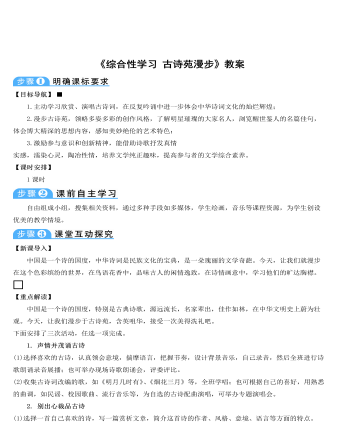
部编版语文八年级下册《综合性学习:古诗苑漫步》教案
【目标导航】1.主动学习欣赏、演唱古诗词,在反复吟诵中进一步体会中华诗词文化的灿烂辉煌;2.漫步古诗苑,领略多姿多彩的创作风格,了解明星璀璨的大家名人,浏览醒世鉴人的名篇佳句,体会博大精深的思想内容,感知美妙绝伦的艺术特色;3.激励参与意识和创新精神,能借助诗歌抒发真情实感,濡染心灵,陶冶性情,培养文学纯正趣味,提高参与者的文学综合素养。【课时安排】1课时自由组成小组,搜集相关资料,通过多种手段如多媒体,学生绘画,音乐等课程资源,为学生创设优美的教学情境。【新课导入】中国是一个诗的国度,中华诗词是民族文化的宝典,是一朵瑰丽的文学奇葩。今天,让我们就漫步在这个色彩缤纷的世界,在鸟语花香中,品味古人的闲情逸致,在诗情画意中,学习他们的旷达胸襟。

